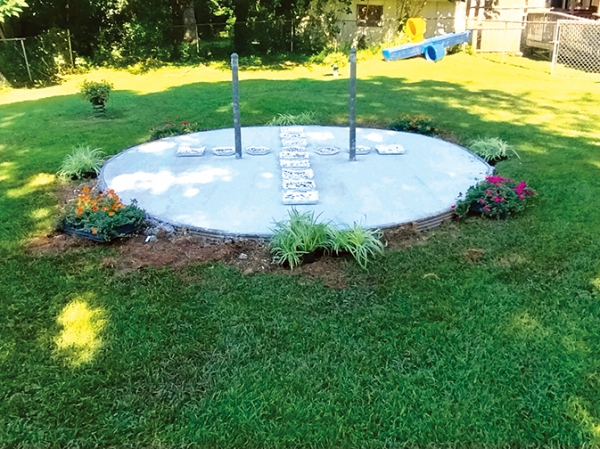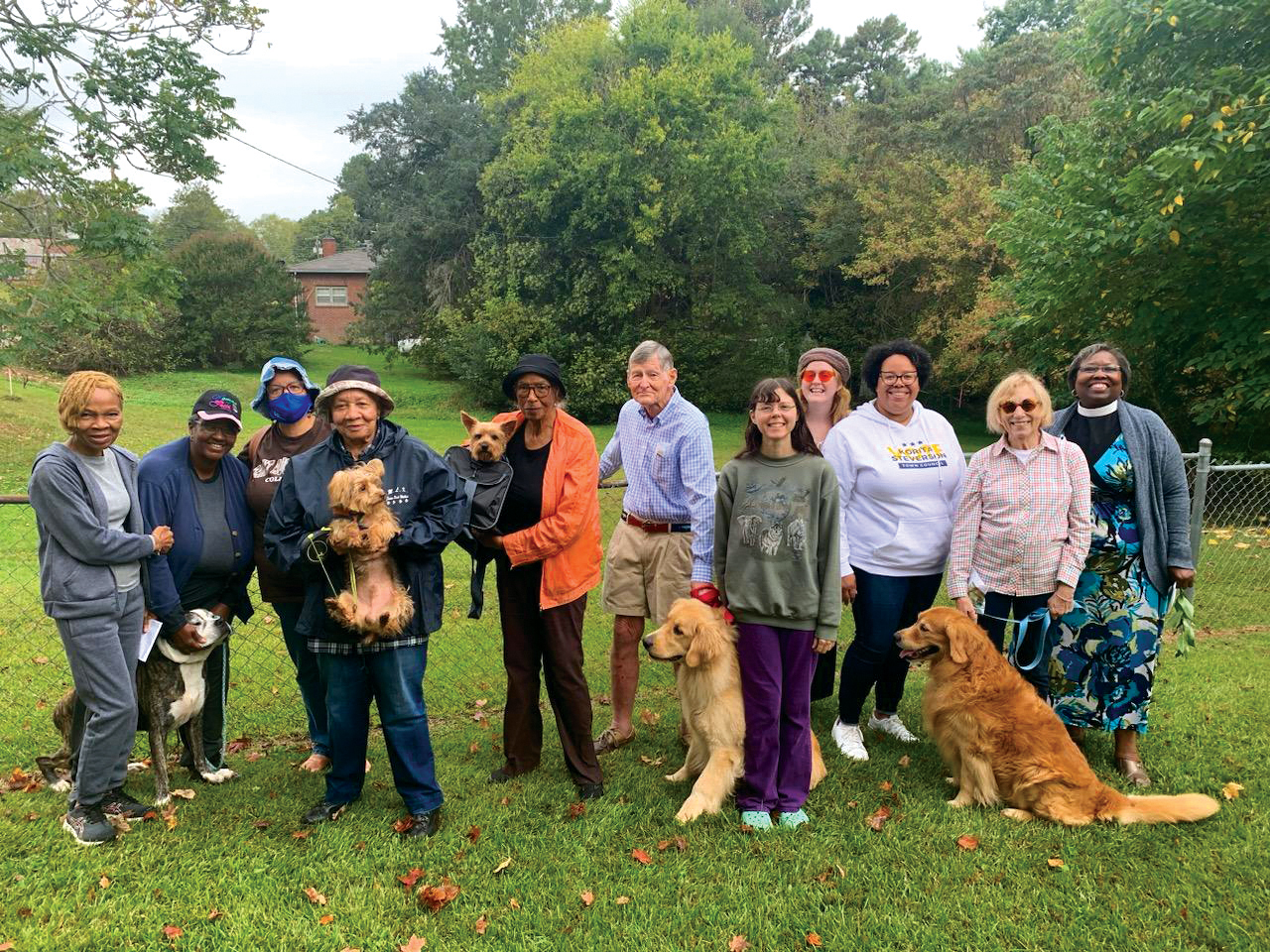Disciple: Making a Place for the Community

How All Saints’, Warrenton, is building toward the future
By Summerlee Walter
Albert and Annie Burges started a day school in their Warrenton home to educate the community’s Black children at the end of the 19th century. The Rev. William Johnston Alston became the first Black person to graduate from an Episcopal seminary in 1860. Bishop Bravid Harris became the first Black Episcopal bishop with ecclesiastical authority over a diocese when he was consecrated as the missionary bishop of Liberia in 1945. Caroline Wiley Cain Bragg is widely considered the mother of the Black Episcopal church in northern North Carolina and southern Virginia. The Rev. Odell Greenleaf Harris was a pioneer for civil rights in the Dioceses of Southern Virginia and Atlanta. The Rev. Thomas Cain served as the first—and for many years after that, the only—Black deputy to General Convention in 1889.
It is Cain in whose memory All Saints’, Warrenton, was built, but all of the luminaries named above were raised up among Warren County’s Black Episcopalians, who started worshiping at All Saints’ in December 1918. While the church’s cornerstone bears Cain’s name, everyone listed above—and many, many more saints, known and unknown—made All Saints’ and the congregation from which it formed a leading force in The Episcopal Church for more than a century.
The county in which All Saints’ is located also has an important legacy. In the fall of 1982, Warren County birthed the environmental justice movement after the State of North Carolina decided to build a hazardous waste landfill in the rural, poor, largely Black county. Despite the historic importance, six weeks of marches, nonviolent street protests and direct action to block roadways, plus ensuing legal challenges, failed to stop the state, and the toxic waste stayed in Warren County.
At the same time, the county, like many rural communities in eastern North Carolina, faced a declining population and fewer resources. All Saints’, too, struggled against the same challenges before celebrating its last regular worship service on June 10, 2015. Now, both are finding creative ways to revitalize the community.
[Image: A cross made of pavers is the focal point of All Saints’ Garden: A Place of Peace and Hope.]
LEVERAGING
In addition to its long history of leadership and culture of service to the community, All Saints’ has several tangible resources the congregation is leveraging into creative new uses as the church plans for the future. The All Saints’ Revisioning Committee, which formed in 2018 and has faithfully discerned the church’s future ever since, is one such resource. Others include the former All Saints’ rectory, which currently houses the Living and Learning Youth Center, and the church grounds, home to the newly planted All Saints’ Garden: A Place of Peace and Hope. The former continues the congregation’s long commitment to education and leadership development in young people, while the latter reflects the local legacy of environmental justice.
At the Living and Learning Youth Center, led by executive director Terry Alston Jones, teenagers can access anger management classes, substance use prevention education, mediation and restorative justice processes to prevent violence and reduce crime, and the R.E.S.E.T. preventative program that helps young people navigate difficult personal situations. Their parents can take classes in the Positive Parenting Program, which teaches parents how to promote their teenagers’ development and manage their behavior in constructive, non-hurtful ways. The center also hosts a two-week summer camp focused on environmental and social justice and mental health. This summer, as part of the mental health focus, attendees crafted decorative pavers for the All Saints’ Garden. The pavers became the garden’s centerpiece and the first piece of landscaping installed.
Even the decision to involve the community’s teenagers in the garden project contains an echo of the church’s legacy. When Bishop Henry Beard Delany, best known as the bishop suffragan of North Carolina, 1918-1928, but also priest-in-charge at All Saints’ for 20 years, led the effort to raise funds for the Thomas Cain Memorial Church from Black Episcopalians around the country, some of the biggest donors included Sunday school classes, whose young learners gave generously.
HEALING
The All Saints’ Garden is designed to be a place of meditation and solace for the community. While still a work in progress, under the leadership of long-time church member Wilhelmina Ratliff the space has already welcomed the community for a Blessing of the Animals service a few weeks after the dedication in August. Future plans include Advent and Christmas celebrations, handing out hot beverages during the town’s Christmas parade, participating in the Warrenton SpringFest, constructing a small stage and seating for programs, and planting more greens and seasonal flowers.
The church also plans to use its land to heal the body in addition to the soul. A recent donation to All Saints’ of land adjacent to the church by the Mary R. Jones Charitable Trust opened up the possibility of growing fresh produce for distribution to the community. In collaboration with Working Landscapes, a Warrenton nonprofit dedicated to expanding access to fresh, healthy, local food, and the nonprofit’s executive director, Carla Norwood, All Saints’ plans to cultivate the donated land to address food insecurity and health issues in the community.
The people of All Saints’, the revisioning committee and their community partners had big plans, but they needed help discerning the path forward to realize their dreams.

[Image: The All Saints’ Garden welcomed the community for a Blessing of the Animals service. Photo courtesy of T. A. Jones, The Warren Record]
PLACEMAKING
When the opportunity arose to participate in the Church & Community Placemaking Lab out of the Ormond Center at Duke University, it was an obvious choice.
“I’m always of the theory you don’t screen yourself out of something,” said Robin Williams, a long-time leader of the All Saints’ community. “You let the process be what it is, and if it is for you, then it will be.”
As it happens, the lab was definitely for All Saints’.
The Church & Community Placemaking Lab is based on the simple but revolutionary observation that “every neighborhood possesses one significant asset: underutilized church property.” All Saints’ is one of six churches in the program’s pilot cohort. (Holy Spirit, Greensboro, is another. Disciple, Summer 2023) During the six months from March to September 2023, All Saints’ worked with a team of church members, local community partners and expert consultants to focus and refine a vision for the church’s future that has been percolating almost since the moment the church closed. Christopher Gergen, Daniel Pryfogle and Garry Cutright from the Ormond Center helped the group see all of the possibilities for the property and imagine what steps they might take to realize those possibilities. Another consultant, John Parker, will help them stay on track as they implement the plan.
One thing that became very clear during the process: All Saints’ needs to incorporate as a 501(c)3 to fully realize its vision. Another thing that became clear is the church building and property once again can serve as a community hub, as they have in the past. The committee envisions repurposing the sanctuary into a space that houses exhibits and memorabilia to preserve and share the history of the Black Episcopal church in Warren County and across the country, including several nearby congregations that have closed: St. Luke’s, Warren County; St. Anna’s, Littleton; and Epiphany, Rocky Mount. They want the displays to be movable so the church can hold worship services at regular intervals and community groups can rent the space. And All Saints’ will continue to expand its offerings through the garden and former rectory.
“We want to make sure that All Saints’ is on the tip of people’s tongues and that we are providing for the needs of our community, which are many,” Williams said.
They don’t plan to do it alone. In addition to partners like Jones, Norwood and consultants from the Ormond Center, All Saints’ also has built relationships with Bishop James Fitz, the elder of In Jesus’ Name Christian Ministry, which worships in the former St. Anna’s; Warrenton town manager Robert Davie, who provided the funding for an environmental survey; and local construction groups, like Environmental Builders.
Currently, the All Saints’ Revisioning Committee and the group that participated in the placemaking lab are working to prioritize the various projects on the horizon. The people of All Saints’ know they won’t accomplish everything immediately, but Williams had one big takeaway from the various models of church-community engagement the cohort explored during the lab.
“Everything’s different, but there’s a common thread: When you go forward in faith, the doors open, and what you will be able to accomplish is beyond your imagination.”
Summerlee Walter is the communications coordinator for the Diocese of North Carolina.
